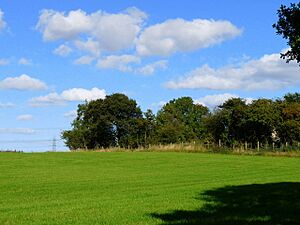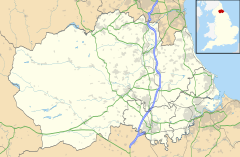Grindon, County Durham facts for kids
Quick facts for kids Grindon |
|
|---|---|
| Village | |
 |
|
| Population | 2,603 |
| OS grid reference | NZ 39923 24791 |
| Civil parish |
|
| Unitary authority |
|
| Ceremonial county | |
| Region | |
| Country | England |
| Sovereign state | United Kingdom |
| Post town | Billingham |
| Postcode district | TS22 |
| Police | Durham |
| Fire | County Durham and Darlington |
| Ambulance | North East |
| EU Parliament | North East England |
| UK Parliament |
|
Grindon is a small village in County Durham, England. It is located between the towns of Sedgefield and Stockton-on-Tees. Grindon is part of the larger parish of Grindon and Thorpe Thewles.
The name "Grindon" comes from an old word, 'dun', which means 'hill'. The area is part of the Upland Fells. These hills are made of a type of rock called Carboniferous millstone grit. The different layers of hard and soft rocks create a unique landscape. This gives the hills a stepped look and flat tops.
Contents
History of Grindon
In 1831, Grindon was a larger area called a civil parish. It included the smaller areas of Grindon and Whitton. Later, Whitton became part of a different parish called Stillington. In 1908, Grindon's boundaries grew again. It then included Embleton from the nearby parish of Sedgefield.
The Grindon parish covered about 4,275 acres of land. A large part of this land was used for farming. About 1,037 acres were for growing crops. Another 1,927 acres were covered in grass. There were also 845 acres of woods and tree plantations. Farmers mainly grew wheat, oats, and barley. These crops grew well because of the special soil. This soil is a mix of magnesian, limestone, and siltstone. This type of soil is unique to the North East region of England.
The Old Church of St. Thomas
The remains of an old church, St. Thomas of Canterbury, can still be seen today. It is located west of what is now Wynyard woodland park. This church was built a very long time ago, between 1153 and 1193. This was during the Norman period in England. It was named after St Thomas a Becket in the early 1200s.
The church was ordered to be built by Hugh de Puiset. He was the great-grandson of William the Conqueror. Hugh de Puiset was also the Bishop of Durham from 1153 to 1195. By the late 1700s, the church was well-kept. It had nice wooden panels and special family seating areas. The church walls also displayed hachments. These were special shields unique to local farming families.
Over time, more people moved from Grindon to the village of Thorpe Thewles. Because of this, a new church was needed there. The Church of Holy Trinity was built in Thorpe Thewles in 1848. The old St. Thomas of Canterbury church was then left to fall into ruins. Today, the ruins are an important historical site. They are protected as a Grade A listed building. This means it is a building of special historical interest.
On April 1, 2019, the old Grindon parish was officially ended. It then became part of the new parish of Grindon and Thorpe Thewles.
Grindon's Population Changes
The number of people living in Grindon has changed a lot over the past 150 years. The population grew quickly between 1811 and 1830. But then it dropped fast until 1842. After that, it slowly increased again. It reached its highest point in 1961.
Part of the population drop was due to a serious illness. An outbreak of cholera happened across England. In 1832, 126 people died around the Grindon area from this disease. The 2001 census counted 2,603 people living in the parish. Most of these people, about 820, were between 25 and 44 years old. Only a small number, 48 people, were aged 75 or older.
Grindon is close to the busy A177 road. This road is used by people traveling to Teesside and Middlesbrough for work. This helps explain why many younger people live in the area. However, this has also led to concerns about the village growing too much. Some worry that Grindon's original character might be lost. This is especially true for nearby villages like Thorpe Thewles, which has important historical sites.
Coal Mining and Growth
In the 1800s, coal became a very important source of energy. This was the start of the Industrial Revolution in Great Britain. Coal helped power factories and grow the British Empire. Northern England played a big part in this. Areas like County Durham had huge amounts of coal.
Many coal miners came from the Stockton-on-Tees area. This helps explain why Grindon's population grew between 1842 and 1961. This was when coal mining was at its busiest. It brought many working-class families to the area. The Chilton mine was the closest one to Grindon.
The fastest period of population growth happened after 1940. This was after World War II. It led to a "baby boom" in England, meaning many babies were born. Also, the National Health Service (NHS) was started in 1948. These things helped the population grow. More people also wanted to live in the countryside after the war.
Jobs in Grindon's Past
In 1831, farming was the main type of work in Grindon. Many men aged twenty and over worked as farm laborers. This was almost one-third of all male jobs. Even though farming was very important, other jobs existed too. Over 20% of jobs were in the "secondary sector." This included shops and craft businesses.
The farm products from Grindon helped feed growing towns and cities. With new ways to transport goods, farm products could be sent to factories. These factories would then process the food. For Grindon, many farm goods went to factories in Middlesbrough. For example, in 1929, a Quaker business bought land in County Durham. This included parts of Grindon. They used this land for farming to supply the growing food industry.
Records from 1881 show that most jobs were in manual labor and production. These jobs were mostly done by men. Women were more often employed in domestic services, like working in homes, or in offices.


